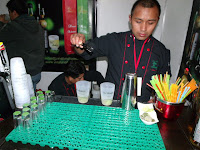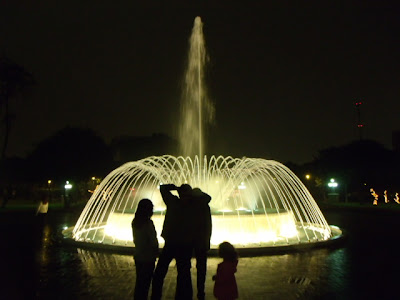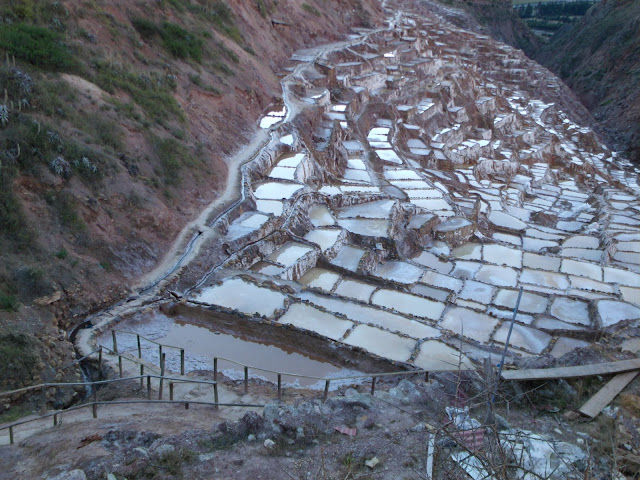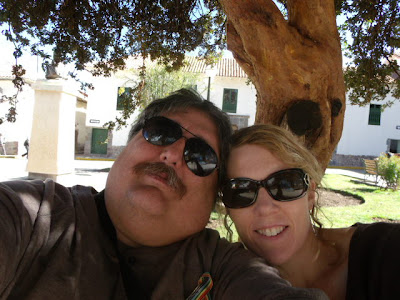As I write we have finished packing for an early-morning departure tomorrow to the southern city of Arequipa, a trip that will include a night spent in the famous Colca Canyon.
Unlike the trip to Cusco, where it was just Liz and I, this time there's eleven of us making the trip. Should be fun, with lots to see, and everyone is looking forward to eating some of the cuisine for which Arequipa is famous throughout Peru.
Tuesday, July 26, 2011
Pisco Day
Sunday was National Pisco Day and at the Circuito de Aguas there was a pisco and marinera festival, so we headed there to enjoy the fountains and have some pisco along the way.
The city had shut down the large, record-setting fountain in the park and in the esplanade around it there had been set up a number of booths run by various pisco producers. We got to try some pisco sours and classic chilcanos, but the stars were some chilcanos at the Sol de Ica booth prepared with pisco infused with fruits, vegetables, and herbs. We tried a blackberry or mulberry chilcano that we weren't that impressed with, but we had our horizons expanded by a chilcano made with sweet basil leaves and cucumber slices, and a spicy one made with aji-infused and ginger-infused piscos.
In addition, we got to watch part of the game between the Peruvian and Spanish national sub-20 teams being played at the National Stadium next door, as it was broadcast on a giant screen at the water park.
Monday, July 25, 2011
Lima Water Park
Last night we -Liz, Diego, Rafa, Miranda, Jacho, and I- headed to the water park -the Circuito Magico de Aguas- as it was host to a pisco and marinera festival for National Pisco Day.
We had quite a time getting to the park as it also happened to be the night of the inauguration of the completely remodeled National Stadium, right nextdoor, with a game between the national youth soccer teams of Peru and Spain. To make things worse, the president arranged for the national soccer team which placed 3rd in the Copa America in Argentina on Saturday to be at the stadium, so the crowds were huge inside the stadium and outside.
Eventually, we made it into the park after 9 o'clock and had a really nice time wandering through the gardens and enjoying the fountains.
Most of the fountains are strictly for viewing, some coreographed to music -as in the one in the video above- but there is one that is interactive and a perennial favourite:
No matter what the season or the weather it is always filled with young people trying their luck at avoiding getting soaked.
Rafa and Liz managed to get through with only their shoes getting wet, but Jacho got hit in the behind with a jet of water!
Friday, July 22, 2011
Feeling better
In coming to Peru people tend to worry -and rightly- about intestinal problems, but we tend to forget that, as in the north, winter here is also flu season. After being laid out for several days with a flu I've finally starting to feel human again.
We went with Willy this morning to take a handwoven Cusqueno blanket to be framed for the living room, and then spent the afternoon at his apartment chatting after a family lunch gathering.
As I write, it is Friday evening and we are sitting at home watching Peru's sub-20 female volleyball team play Egypt in the 2011 World Cup, and I'm chewing on BUK cough drops.
BUKs -or pastillas BUK, as we call them in Spanish- have a long history with our family, as our great-aunt Alicia -Mama Pali's sister- used to own the Dover pharmacy on Ave. Arenales, and she would give us a pack of BUKs as a treat whenever we visited her at the pharmacy.
Don't know what we'll do later, if anything, but we're looking forward to the weekend and to next week's trip to Arequipa.
We went with Willy this morning to take a handwoven Cusqueno blanket to be framed for the living room, and then spent the afternoon at his apartment chatting after a family lunch gathering.
As I write, it is Friday evening and we are sitting at home watching Peru's sub-20 female volleyball team play Egypt in the 2011 World Cup, and I'm chewing on BUK cough drops.
BUKs -or pastillas BUK, as we call them in Spanish- have a long history with our family, as our great-aunt Alicia -Mama Pali's sister- used to own the Dover pharmacy on Ave. Arenales, and she would give us a pack of BUKs as a treat whenever we visited her at the pharmacy.
Don't know what we'll do later, if anything, but we're looking forward to the weekend and to next week's trip to Arequipa.
Tuesday, July 19, 2011
Birthday Dinner
Last night, it being the eve of my birthday, Liz and I invited a number of the aunts, uncles, and cousins to dinner at the Restaurante Royal, a large Chinese restaurant near San Felipe.
We had a great enjoying the good company and some delicious food. We've got some leftovers, and were planning on enjoying those at lunch today and tonight as Peru plays Uruguay in the semifinals of the Copa America, but Liz and I have both gotten a cold. So, we'll have to see what we're feeling up to later on...
We had a great enjoying the good company and some delicious food. We've got some leftovers, and were planning on enjoying those at lunch today and tonight as Peru plays Uruguay in the semifinals of the Copa America, but Liz and I have both gotten a cold. So, we'll have to see what we're feeling up to later on...
Devils on the rooftops
In Paucartambo -and in other Cusco towns- during the feast days of the Virgen del Carmen, in mid-July, dance troupes associated to specific religious fraternities take to the streets and, through their dances, essentially act out religious plays. One set of important characters in these are the saq'ras, or devils, who haunt the streets surrounding the church -being unable to enter it- and on the last day of the festival, when the effigy Virgin is carried in procession through the streets, the saq'ras are reduced to haunting the rooftoops and treetops, emiting their trilling cries, and waving their canes at the Virgin and her worshippers.
In Cusco, on the afternoon of the 7th, as part of the celebrations of the 100th anniversary of the "discovery" of Machupiqchu, Cusquenos made an effort to bring out elements of their folklore. Accordingly, we found a troupe of saq'ras haunting the Plaza Espinar and the Basilica de la Merced.
As Liz said at the time, we were pretty lucky to have chosen those days to be in Cusco!
As Liz said at the time, we were pretty lucky to have chosen those days to be in Cusco!
Saturday, July 16, 2011
Cusco: Celebrations
While we were in Cusco there was celebrated the 100th anniversary of Hiram Bingham's announcement of the existence of Machupiqchu. As part of the celebrations -aside from a ceremony and concert in Machupiqchu itself- there were musical acts and a concert in Cusco's main square.
Some of the acts were folkloric dance groups, called comparsas. The first of the below is from Cusco's Paucartambo province, and the sencond, from Puno.
Some of the acts were folkloric dance groups, called comparsas. The first of the below is from Cusco's Paucartambo province, and the sencond, from Puno.
Labels:
Celebrations,
Cusco,
Events,
Historic Events,
Music,
Video
Friday, July 15, 2011
Maras
Our last stop in the Sacred Valley was a spot on the western rim that I had been curious to visit for some time: the salineras (saltworks) at Maras. The normal tour of the northern part of the valley passes through the market at Pisaq -skipping the ruins-, lunch at Urubamba, the ruins at Ollantaytambo, and the market and church in Chinchero- but I had instructed our hired driver -a really nice guy named Javier- to skip Urubamba and Chinchero- and make sure to get us to Maras.
The Maras saltworks have been in operation since Inca times and likely well before that. One side of the little valley where they are located has been terraced and the terraces are filled with salt water that emerges from a single spring in the mountainside.
Each family controls 10 to 20 pans. The salt spring's water is channeled and diverted so that all the
terraces' pans are filled, and the water is allowed to evaporate and the
salt to concentrate, until it forms a layer thick enough to be
harvested. The salt is then bagged and shipped out to market, mostly for agricultural use, though some -mainly from the purer top layers is packed in small amounts, labeled, and sold in Cusco, and at the works themselves, for medicinal and culinary use.
We bought about a half kilo of salt to bring back to US with us and some to leave here in Lima. The salt is not "sweet" like fleur de sel nor minerally like Indian kali namak. The overall impression is of ... well, ... saltiness.
Wednesday, July 13, 2011
Pisaq
Our first stop in the Sacred Valley was in the town of Pisaq. Pisaq is a market town, famed for its Sunday fair, which is held in the town's main square, dominated by a large and venerable pisonay tree. The tree is a distinctive feature of the town, and it has been there so long that it is nearly impossible to think of Pisaq without it. The town is easily identifiable in early photographs because of the tree.
Pisaq was established by the Spanish in the 1500s but it lies at the foot of the Inca site of Pisaq. Before asking our driver to take us up the mountain to the ruins, we did a bit of shopping, buying some masks to decorate our Lima apartment with.
In that regard I have to mention the service we received at Artesanias Pisonay on Pisaq's main square. When we were short of cash, the owner offered to take a small deposit and deliver the masks to our hotel the next day. Granted, by buying four of their more expensive masks, we were likely making their week's sales in one day, but Alicia, the owner, really did go out of her way to help us get what we wanted. She made a special trip to Cusco, and arrived when she said she'd be there (in fact she apologized for being 10 mins "late", which most of time in Peru doesn't even count!) She even brought the packing materials we had requested.
In any case, after that, we moved to visit the ruins of Inca Pisaq.
No one is quite sure who ordered Inca Pisaq built or when, but it seems likely that it was established in the the 1470s or thereabouts, and was perhaps intended to mark the Inka Pachakutiq's triumph over the tribes of the Antisuyu. It had a clear agricultural purpose, what with its numerous terraces encompassing an area larger than Machupiqchu. However, it also likely served a military purpose, overlooking the pass that contains the Inca roadway toward the lowlands of the Antisuyu and being marked on that side by a strong defensive wall.
 |
| Defensive wall along the southern side of Pisaq, and Amaru (serpernt) Gate |
 |
| The Amaru (serpent) Gate on the path to the temple of the sun in Pisaq |
Pisaq is also notable for containing the largest identified Inca cementery. Along a cliff, set so that they face the rising sun, hundreds of Inca ossuaries are set into the cliff face. When I visited Pisaq as a lad of 14 in 1981, there were some tombs yet unraided. I doubt that today any are left unopened.
 |
| Inca cementery |
 |
| Inca baths |
 |
| Inca Pisaq's residential sector |
Tuesday, July 12, 2011
The Sacred Valley
On the 6th, our 2nd day in Cusco, Liz and hired a car and driver to take into to Urubamba Valley. We opted for doing it that way instead of joining an organized tour so that we could set the schdule ourselves, stop when we needed a break, and determine the places to visit ourselves.
The Urubamba Valley, also known as the Sacred Valley, was the breadbasket of Inca Cusco, with its mild climate and diverse ecological zones. It was -and is- optimum land for growing corn, and Cusco corn is famed for its size and quality to this day. The Incas lined the valley with agricultural terrraces, carrying fertile bottomland soil up the slopes by the basketful to create vertical fields, and brought in experienced maize farmers from elsewhere in the empire to settle the valley.
The Incas prized the valley as the Inca heartland, holding it as sacred. The Inca nobility established country palaces along the valley, and built temples all along its length. Accordingly, the valley contains a number of important Inca archaeological sites, principally Tipon, Pisaq, Ollantaytambo, Moray, and Machupiqchu. Of these, we were to visit Pisaq and Ollantaytambo, along with the saltworks at Maras.
 |
| The Sacred Valley, viewed from Pisaq |
 |
| Eastern slope of the Sacred Valley, viewed from near Maras |
Labels:
Andes,
Archaeology,
Cusco,
Incas,
Ollantaytambo,
Pisaq
Sunday, July 10, 2011
Cuzco
One of the best things about Cuzco is, well, that it´s Cuzco - a modern city superimposed upon a Spanish colonial city built atop the capital of the Inca empire. Everywhere one looks in the downtown portion of town, there are vestiges of the city´s past visible: colonial mansions and churches, Inca walls and foundations, the layout of the streets - even the entrance to our hotel.
 |
| Hotel Rumi Punku |
At the heart of ancient Cuzco lay the twin plazas of Aucaypata and Cusipata, divided by the Saphy river, which was paved over in ancient times and still runs under the city. The two plazas thus made up a single large open space. Aucaypata (the Plaza of War) was the site for state ceremonies and became the current Plaza de Armas.
 |
| Plaza de Armas, with the Church of the Company of Jesus visible |
Of Cusipata all that remains is a small square a block from the Plaza de Armas, still known as the "Plaza of Joy" - the Plaza Regocijo.
 |
| Plaza Regocijo |
Surrounding the ancient, and modern square, were structures that housed the mansions of the Inca nobility, and the Aqllawasi, a sort of convent where "chosen women" served the Inca and the state religion by brewing chicha corn beer and weaving fine cloth.
On our first day in town, Liz and I wandered those streets, many of which still bear their Inca names, soaking in the sights and the history of it all.
We walked down Hatun Rumiyoq, the Street of the Large Stones, admiring the walls of the former palace of the Inka Pachacutiq, and down Loreto Kiqllu (formerly known as Intiqkiqllu, the Street of the Sun) which is lined with some of the finest stonework in Cuzco, in the walls of the former Aqllawasi (which was turned into the Convent of Santa Catalina).
 |
| 12-Angle Stone, in the wall of the former Palace of the Inka Pachacutiq, on Hatun Rumiyoq |
 |
| Hatun Rumiyoq |
 |
| Old Archbishop's Palace, erected atop the foundations of Pachacutiq's palace |
 |
| Convent of Santa Catalina |
 | ||
| Basilica of La Merced |
 |
| Street of the Seven Snakes |
Note: Edited to add a few more photos.
Labels:
Andes,
Archaeology,
Architecture,
Cusco,
Historic Sites,
Incas
Saturday, July 9, 2011
Hi. Got back from Cusco last night, after spending four days and three nights there. We toured the Sacred Valley and the main sites around town. We were also lucky that our stay in the city coincided with the celebrations for the 100th anniversary of Machu Picchu being brought to the world's attention by Hiram Bingham. There were street events and a concert in the plaza.
Right now, between the internet connection at the apartment being unsteady at the moment and Blogger's new software still being a bit buggy, I can't do much more that this brief update. So, as they say: More later ....
Right now, between the internet connection at the apartment being unsteady at the moment and Blogger's new software still being a bit buggy, I can't do much more that this brief update. So, as they say: More later ....
Thursday, July 7, 2011
In Cuzco
We´re in Cuzco. Did the Sacred Valley tour yesterday, and after climbing all those stairs my knees and thighs are complaining!
Right now I´m at a cafe overlooking the Plaza in Cuzco, getting ready to listen to a concert by legendary Peruvian rocker Miki Gonzalez staged for the 100 anniversary of Hiram Bingham´s finding Machu Picchu.
Right now I´m at a cafe overlooking the Plaza in Cuzco, getting ready to listen to a concert by legendary Peruvian rocker Miki Gonzalez staged for the 100 anniversary of Hiram Bingham´s finding Machu Picchu.
Saturday, July 2, 2011
Munich
Take one old bar, add an ancient piano and one ancient piano player, toss in 1 L steins of cold beer and big plates of sausage and potatoes and you've got a recipe for success, if downtown Lima's Munich Piano Bar is anything to measure by.
Tonight, being "Friend Day" -a "holiday" invented a couple of years ago by one of the big beer companies-, we decided to go downtown for a stroll and a beer. After walking from the Plaza de Armas, overlooked by the Presidential Palace, to the Plaza San Martin, we headed to the Munich, where neither Liz nor I had been before.
Located down a set of stairs off of Calle Belen (also known as Jiron de la Union), and though a barrel-shaped door, Munich has long been a favored hangout for students of the nearby San Marcos and Federico Villareal universities, and for downtown workers.
Tonight, every seat in the place was full, and it took us a few minutes to get a table. Of course, being in the Munich, we ordered what the Munich is known for: 1 L jugs of beer and the Piqueo Munich (Munich Appetizer), which is a grand plate of salchipapas made with three kinds of wurst.
Munich was founded in 1954 -I think by a German immigrant- and soon established its place in Lima's bohemian night scene, becoming one of the city's classic bars. Difficult finances led the original owner to despondence and, eventually, to suicide. His widow tried to run the place for a while but eventually decided to turn it over to the employees, who have run it ever since, and they do seem to do a good job of it.
This evening, business was booming, and a steady stream of people wandered in hoping for a table and showed no sign of slowing when we left around 11 pm. One can hardly blame them, for despite the booming of a discotheque right next door, the old school atmosphere of the Munich makes for a pretty cool watering hole.
Munich Bar
Jirón de la Unión 1044
Lima (Cercado)
This evening, business was booming, and a steady stream of people wandered in hoping for a table and showed no sign of slowing when we left around 11 pm. One can hardly blame them, for despite the booming of a discotheque right next door, the old school atmosphere of the Munich makes for a pretty cool watering hole.
Munich Bar
Jirón de la Unión 1044
Lima (Cercado)
Friday, July 1, 2011
San Felipe turns 45
Forty-five years ago today the first phases of the Residencial San Felipe were innaugurated, and to mark the occasion, there was a small ceremony this afternoon in the plaza of the complex's commercial sector attended by the mayor of the burrough of Jesus Maria, Enrique Ocrospoma, and the students from San Felipe's three pre-schools.
San Felipe is a large residential complex comprised of some 40 buildings amidst walkways and gardens. It was the brainchild of then President Fernando Belaunde, and is a unique space in this city. When it was built it comprised the largest collection of tall buildings in the country -"Little Manhattan" it was called- and was visible from almost any point the city.
Here's what I wrote about it a few years ago:
Today San Felipe has a birthday.
Started as project by President Fernando Belaúnde Terry, who was an archictect in regular life, the Residencial San Felipe was inaugurated forty-two years ago, on July 2, 1966. At the time, with almost 50 buildings in five distinct styles holding apartments for over 10,000 people, it was one of the largest -if not the largest- housing project in all of Peru.
The complex was planned and built, on the grounds of a former hippodrome, as a single huge block with no cross-traffic and interlaced with sidewalks and gardens, and including three preschools and a shopping center. Over time a cooperative school and a chapel were established on the grounds and a clinic was built across the street, meaning that residents could have almost all their needs met within the Residencial itself.
Into the 1980s the Resi was a dominant feature on the Lima skyline, its 15-storey buildings topped only by the former Ministry of Education on Avenida Abancay and the Banco de Credito tower in Miraflores.
its four decades San Felipe has remained a distintict neighborhood, with many of the original families still occupying their apartments. Its mix of buildings and large green areas are unmatched anywhere else in the city, leading to lower levels of noise and atmospheric pollution within its boundaries than is the average in this sprawling city. Its gardens abound with birds and butterflies, and it is even said that they harbor an endemic type of blind snake.
The neighbors recently won an important victory when they defeated a move by the mayor of Jesús María and a grocery store chain to take over part of the parking areas and build a larger supermarket and movie theatre. The neighbors insisted that the project was unecessary and would harm their quality of life by increasing foot and vehicle traffic while reducing parking, arguing that the parking areas -like the gardens- are held in condominium by the neighbors and are not for the municipality to dispose of at will.
Confronted by the organized neighbors, who staged rallies, and weekly cacerolazos in which pots and pans would be banged together from apartments all over the resi at 8:00 pm sharp every Saturday, and a media and internet campaign, the Plaza Vea chain backed out and the mayor backed down.
Such is the hold that San Felipe has on those who live and have lived here, that there is a Facebook group dedicated to it that draws current and former residents from all over the world -as far away from Lima as Europe and New Zealand.
Tonight the celebration of the anniversary will continue with further ceremony and a dance in the plaza and some of us participants in the group who happen to be in Lima will use the opportunity for a face-to-face meeting and, in some cases, reacquaintance. Should be fun!
Labels:
Architecture,
Celebrations,
Events,
Jesus Maria,
Lima,
Politics and Government,
San Felipe
Subscribe to:
Comments (Atom)
































